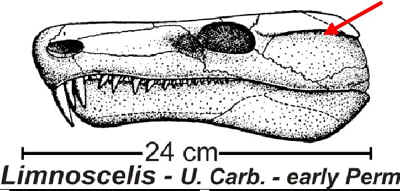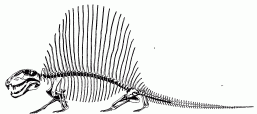
Limnoscelis - a large reptile-like tetrapod
| Cisuralian Epoch | ||
| Paleozoic: Permian Period |
Sakmarian Age |
| Asselian | Pennsylvanian | Cisuralian | ||
| Artinskian | Guadalupian | Timescale |
 |
|
Limnoscelis - a large reptile-like tetrapod |
Age |
Tetrapod Zone |
Time* |
Location |
|||||
USA |
India |
|||||||
Utah, Colorado |
New Mexico |
Texas |
Oklahoma |
Pennsylvania |
Himalayas |
|||
Sakmarian |
4 |
283 284 285 286 287 288 | Organ Rock Shale |
|
Admiral |
Wellington Formation |
|
Kashmir |
3 |
|
Abo |
Putman |
|
Green |
|
||
2 |
Hotgaita Shale |
|
Moran |
|
|
|||
|
Table based on J. M. Anderson & A. R. I. Cruikshank, "The Biostratigraphy of the Permian and Triassic, Part 5, a review of the classification and distribution of Permo-Triassic Tetrapods," in Paleontologica Africana, 21, 15-44 (1978); slightly modified. * approximate time in MYA (millions of years ago) - nearest million year intervals |
||||||||

Eryops megacephalus
Class Tetrapoda
Order Temnospondyli
Superfamily Eryopoidea
Family Eryopidae
Witchita Series (Wolfcampian age), Texas Red Beds
Standard total length from 1.5 to 2 meters
Adults weigh in at about 130 kg
Predator of other stem tetrapods
a large carnivorous aquatic tetrapod, which seems to have persisted with no change for some 20 million years or so
Plesion Synapsida (Theropsida)
Order Pelycosauria
Suborder Eupelycosauria
Family Sphenacodontidae
from the Abo/Cutler Formation
New Mexico, USA
Adult standard total length of 225 cm
Adults weigh in at 129 kg
Predator of other stem tetrapods
Almost identical to Dimetrodon, except that it lacks the famous "sail". Sphenacodon lived in a different region (separated by an expanse of sea) from most species of Dimetrodon (apart from the small contemporary D. occidentalis), and was the size of larger and later species of the latter.

Dimetrodon milleri
Plesion Synapsida (Theropsida)
Order Pelycosauria
Suborder Eupelycosauria
Family Sphenacodontidae
from the Putnam Formation, Wichita Group
Texas, USA
Adult standard total length of 174 cm
Adults weigh in at 47 kg
Predator of smaller Tetrapods
a small, rare form, this is the stratigraphically earliest of the many Dimetrodon species recovered from Texas.
Known specimens consist of one nearly complete and two partial skeletons

Ophiacodon retroversus
Plesion Synapsida (Theropsida)
Order Pelycosauria
Suborder Eupelycosauria
Family Ophiacodontidae
Admiral Formation, Witchita Series (Wolfcampian age), Texas Red Beds
Adult standard total length of 2.5 meters
Adults weigh in at 120 kg
Predator of mostly fish, perhaps also small aquatic tetrapods
a large species of the Ophaicodontid lineage. These creatures apparently grew progressively bigger through time.
The skull is very deep and long, not unlike phytosaurs such as Nicrosaurus. It has been suggested that Ophiacodon was a fish-eating form that lived largely along the shores of streams and ponds.

Dimetrodon limbatus
Plesion Synapsida (Theropsida)
Order Pelycosauria
Suborder Eupelycosauria
Family Sphenacodontidae
Admiral and Bell Plains Formations, Wichita Group,
Texas, USA
Adult standard total length of 256 cm
Adults weigh in at 146 kg
Predator of other Tetrapods
a large animal, representing the trend in increase in size of successive Dimetrodon species. It seems to be less common than smaller contemporary species
Known specimens consist of a skull and other skeletal elements
Romer, A.S. and Price, L.I. Review of the Pelycosauria, Geological Society of America Special Papers,. no.28,
Robert R. Reisz, Pelycosauria, Encyclopedia of Paleoherpetology, Part 17A, 1986, Gustav Fischer Verlag, Stuttgart and New York
The Sam Noble Oklahoma Museum of Natural History - Collections - Vertebrate Paleontology - Lists a number of specimens of late Sakmarian age (Wellington Formation)